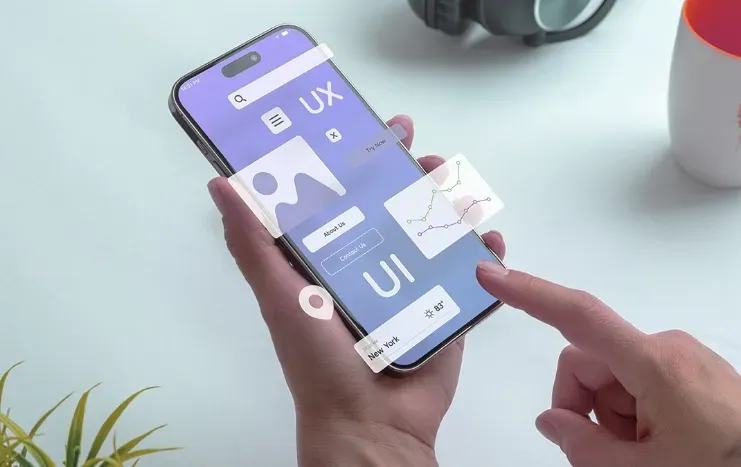Introduction
With over 6.5 billion smartphone users worldwide in 2025, mobile has firmly overtaken desktop as the primary way people access websites and apps. Consumers expect seamless, intuitive mobile experiences—whether they are shopping online, reading news, or booking appointments.
For businesses, this means designing with a mobile-first mindset is no longer optional; it’s essential. A poorly optimised mobile experience leads to high bounce rates, low conversions, and lost customer trust. On the other hand, a well-designed mobile UX drives engagement, loyalty, and higher revenue.
This article explores why mobile-first UX design is critical in 2025 and outlines the best practices you need to deliver fast, user-friendly, and accessible mobile experiences.
Why Mobile-First UX Design Matters in 2025
1. Mobile is the Primary Device for Most Users
According to industry reports, over 70 percent of global web traffic now comes from mobile devices. If your mobile experience is frustrating, users are unlikely to return, regardless of how good your desktop version is.
2. Google’s Mobile-First Indexing
Google now prioritises mobile versions of websites for indexing and ranking. A poor mobile UX directly impacts your search engine visibility and organic traffic.
3. Mobile Users Expect Speed and Simplicity
Smartphone users are typically on the go, multitasking, and looking for quick answers. If they can’t find what they need in seconds, they move to competitors.
4. Conversions Happen on Mobile
From e-commerce to booking services, mobile is becoming the primary conversion channel. Optimising mobile UX directly boosts sales and leads.
5. Brand Perception is Linked to Mobile Experience
A clunky mobile experience makes your brand appear outdated or unreliable. A smooth, modern design enhances credibility and trust.
Key Principles of Mobile-First UX Design
Before diving into best practices, it’s important to understand the foundational principles:
- Progressive Enhancement – Start with mobile as the base design and progressively add features for larger screens.
- Minimalism and Focus – Keep only essential elements on mobile to avoid overwhelming users.
- Touch-Friendly Interfaces – Design for fingers, not cursors. Buttons, forms, and links should be easy to tap.
- Content-First Approach – Prioritise important content and features at the top of the page.
- Context Awareness – Mobile users often interact in different environments (on the move, outdoors), so UX must be quick and distraction-friendly.
Best Practices for Mobile-First UX Design
Now, let’s explore the best practices you should follow to deliver outstanding mobile experiences in 2025.
4.1 Prioritise Content Hierarchy
Mobile screens have limited space, so you must present information in a clear, prioritised manner.
Actionable Tips:
- Place critical content (product details, pricing, call-to-action buttons) above the fold.
- Use collapsible sections (accordions) for secondary information.
- Apply clear headings and bullet points to improve scanability.
For example, e-commerce sites should show product images, price, and “Add to Cart” buttons upfront, with specifications hidden under expandable sections.
4.2 Optimise for Touch Interactions
Mobile interactions depend on fingers, not precise mouse clicks. Poorly spaced buttons or small tap targets frustrate users.
Actionable Tips:
- Maintain a minimum 44x44 pixel tap target size (as recommended by Apple and Google).
- Leave enough space between clickable elements to avoid accidental taps.
- Use swipe gestures where appropriate, such as image carousels or deleting items from a list.
This is especially important for checkout pages, where accidental taps can cause users to abandon their carts.
4.3 Ensure Fast Loading and Core Web Vitals Optimisation
Mobile users expect speed. A one-second delay in loading can reduce conversions by up to 7 percent.
Actionable Tips:
- Compress images and use next-gen formats like WebP.
- Implement lazy loading for images below the fold.
- Minify CSS and JavaScript to reduce file sizes.
- Monitor Google’s Core Web Vitals (LCP, FID, CLS) for optimal performance.
A fast, smooth-loading site doesn’t just please users; it improves search rankings as Google now prioritises performance.
4.4 Design for Accessibility and Inclusivity
A truly user-friendly mobile UX should work for everyone, including users with visual, auditory, or motor impairments.
Actionable Tips:
- Maintain high colour contrast for readability.
- Provide text alternatives for images.
- Ensure buttons and links are accessible via screen readers.
- Avoid relying solely on colour to convey information (e.g., use icons or labels).
Accessible design not only expands your audience but also improves your brand’s reputation as inclusive and customer-focused.
4.5 Simplify Navigation with Intuitive Menus
Mobile navigation should be simple, intuitive, and easy to reach with one hand.
Actionable Tips:
- Use sticky navigation bars at the bottom of the screen for thumb-friendly access.
- Limit menu options to 5–7 core items to reduce cognitive load.
- Include a prominent search bar for quick access.
- Avoid multi-level dropdown menus, which are difficult to use on small screens.
For instance, popular apps like Instagram keep their navigation icons within easy thumb reach, reducing user effort.
The Role of Visual Design in Mobile UX
Visual design plays a critical role in mobile user experience. On smaller screens, visual clarity and aesthetic balance directly influence usability and brand perception.
1. Use Clean, Minimalist Layouts
A cluttered mobile interface overwhelms users. Stick to minimalist layouts that highlight key content and call-to-action buttons.
2. Prioritise Readability
Choose mobile-friendly fonts, maintain proper spacing, and keep line lengths short for easy reading. Aim for a font size of 16px or larger for body text.
3. Consistent Branding
Colours, typography, and imagery should align with your brand identity, reinforcing trust and recognition across devices.
4. Leverage Visual Hierarchy
Use contrasting colours, bold headings, and larger buttons to guide users toward important actions such as “Buy Now” or “Subscribe.”
5. Optimise Images and Videos
Use high-quality visuals that load quickly. Responsive images ensure that media adapts to different screen sizes without distortion.
Step-by-Step Guide to Creating a Mobile-First UX Strategy
Many businesses underestimate the importance of continuous testing and iteration in mobile UX. After launching a mobile-first design, you should regularly conduct A/B testing to identify which layouts, button placements, or call-to-action (CTA) texts drive the highest conversions. For example, testing two different checkout button colours or placements can reveal which one results in fewer abandoned carts.
Additionally, micro-interactions, small animations or haptic feedback when users complete an actioncan make the mobile experience feel more intuitive and satisfying. Simple effects, like a button slightly “bouncing” after being tapped, provide visual confirmation that the system is responding, improving user trust.
Step 1: Understand User Behaviour
Conduct user research to determine how customers interact with your mobile site or app. Analyse heatmaps, session recordings, and surveys to identify pain points.
Step 2: Design for Mobile First, Then Scale Up
Start by designing for the smallest screen size and progressively add features for larger screens. This ensures essential content and functionality remain the priority.
Step 3: Map the Mobile User Journey
Outline every step users take, from landing on your page to completing a conversion. Identify moments where they might drop off and simplify those touchpoints.
Step 4: Prototype and Test Early
Use wireframes and prototypes to test mobile designs before development. Gather feedback through usability testing to refine layouts and navigation.
Step 5: Focus on Thumb-Friendly Zones
Position key actions, like navigation buttons and CTAs, within the thumb-friendly area (lower half of the screen) to reduce user strain.
Step 6: Implement Performance Optimisation from the Start
Work with developers to optimise load times, minimise scripts, and ensure smooth animations early in the design process.
Step 7: Continuously Monitor and Improve
Use analytics tools like Google Analytics and Hotjar to track bounce rates, session durations, and conversion rates. Update the UX regularly based on data insights.
Common Mistakes to Avoid in Mobile UX Design
1. Ignoring Mobile-First Indexing Requirements
Some businesses still design for desktop first, resulting in poor mobile SEO performance.
2. Overloading Pages with Content
Cramming too much information on small screens overwhelms users and increases bounce rates.
3. Using Small or Hard-to-Tap Buttons
Tiny buttons frustrate users and lead to accidental clicks.
4. Neglecting Accessibility
Failing to include alt text, proper contrast, or screen reader support excludes a significant portion of your audience.
5. Forgetting Cross-Device Testing
Designs that look good on one mobile device may appear broken on others. Always test on multiple screen sizes and operating systems.
Case Studies of Brands Winning with Mobile-First Design
1. Airbnb’s Seamless Mobile Booking
Airbnb’s mobile-first design uses clean layouts, bold imagery, and intuitive filters, making it easy for users to find and book accommodations quickly.
2. Nike’s Mobile App Experience
Nike’s app focuses on personalisation, offering tailored product recommendations and an easy-to-navigate shopping experience, boosting mobile conversions.
3. Starbucks’ Mobile Ordering System
Starbucks optimised its mobile app for fast ordering and payment, integrating loyalty rewards. This convenience significantly increased mobile sales.
4. Zara’s Mobile E-Commerce
Zara uses a minimalist mobile design with thumb-friendly navigation and fast-loading visuals, improving both usability and brand perception.
Future Trends in Mobile UX for 2025 and Beyond
Another emerging trend is progressive web apps (PWAs) becoming more common for mobile-first experiences. PWAs offer app-like functionality such as offline browsing, push notifications, and faster loading, without requiring users to download an actual app. This makes them ideal for businesses that want to combine web and app experiences seamlessly.
We can also expect biometric authentication—such as fingerprint or facial recognition—to become standard for mobile logins and payments. This not only speeds up the user journey but also increases security, a crucial factor for e-commerce and banking apps.
Lastly, eco-friendly UX will gain importance. Designers will optimise mobile apps to reduce data consumption and battery drain, aligning with growing consumer demand for sustainable technology.
Here are some other upcoming trends:
1. Voice-Enabled Navigation
Voice commands will become more common in mobile apps, allowing hands-free interactions.
2. AI-Powered Personalisation
Mobile UX will use predictive AI to deliver hyper-personalised content and product recommendations in real time.
3. Augmented Reality (AR) Experiences
Retailers will integrate AR to let users virtually try on clothes or visualise furniture in their homes directly from their smartphones.
4. Gesture-Based Interfaces
Expect more swipe, pinch, and tap gestures, reducing the need for visible buttons.
5. Dark Mode and Adaptive Themes
More apps will adopt dark mode and auto-adjusting colour schemes based on user preferences and environmental lighting.
Summary
Mobile-first UX design is essential for delivering fast, intuitive, and engaging user experiences in 2025. By focusing on content hierarchy, touch-friendly interactions, fast load speeds, and accessibility, businesses can improve usability, increase conversions, and strengthen brand perception.
Adopting a mobile-first mindset isn’t just about smaller screens—it’s about designing simpler, more focused experiences that users appreciate. Brands that continuously optimise their mobile UX will remain competitive and enjoy higher engagement and customer loyalty.
If you’re ready to create mobile-first experiences that drive results, Trinergy Digital can help. Contact us today to build mobile-friendly websites and apps that delight your customers.
FAQs
1. Why is mobile-first UX important in 2025?
Most users browse and shop primarily on mobile, making mobile-friendly UX essential for engagement and conversions.
2. How does mobile-first design affect SEO?
Google prioritises mobile-friendly sites in its rankings through mobile-first indexing, improving organic traffic.
3. What tools can help test mobile UX?
Use Google Mobile-Friendly Test, Hotjar, and BrowserStack for testing usability across devices.
4. Should I design for mobile first or responsive design?
Start with mobile-first to ensure core functionality works on small screens, then scale up to tablets and desktops.
5. How often should I update my mobile UX?
Review analytics and update at least quarterly to address changing user behaviours and new design trends.
Suggested Internal Links
- Professional Web Development Services
- User Experience Design Services
- Marketing Success Stories from Trinergy Digital
Suggested External Sources
- Google: Mobile-First Indexing Guidelines
- Nielsen Norman Group: Mobile UX Research
- Statista: Global Mobile Usage Trends









Comments